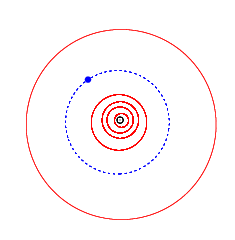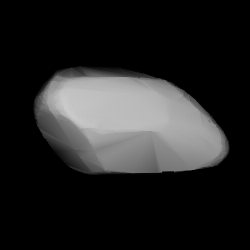Related Research Articles

2985 Shakespeare (prov. designation: 1983 TV1) is a stony Koronian asteroid from the outer region of the asteroid belt. It was discovered on 12 October 1983, by American astronomer Edward Bowell at Lowell's Anderson Mesa Station near Flagstaff, Arizona, and later named after William Shakespeare. The presumed S-type asteroid has a rotation period of 6.1 hours and measures approximately 10 kilometers (6.2 miles) in diameter.
6433 Enya, provisional designation 1978 WC, is a stony background asteroid from the inner regions of the asteroid belt, approximately 7 kilometers in diameter. It was discovered on 18 November 1978, by Czech astronomer Antonín Mrkos at the Kleť Observatory in the Czech Republic. It was named for Irish musician Enya.

9999 Wiles, provisional designation 4196 T-2, is a Koronian asteroid from the outer region of the asteroid belt, approximately 6 to 7 kilometers in diameter. It was named after British mathematician Andrew Wiles.

9994 Grotius, provisional designation 4028 P-L, is a stony Rafita asteroid from the middle regions of the asteroid belt, approximately 3.5 kilometers in diameter. It was discovered during the Palomar–Leiden survey in 1960, and named after Dutch jurist Hugo Grotius.

9971 Ishihara is a stony Flora asteroid from the inner regions of the asteroid belt, approximately 5 kilometers in diameter. It was discovered by Japanese amateur astronomers Kin Endate and Kazuro Watanabe at Kitami Observatory on 16 April 1993, and named after Takahiro Ishihara, president of the astronomical society at Hiroshima.
19741 Callahan (provisional designation 2000 AN141) is a stony background asteroid from the inner regions of the asteroid belt, approximately 3.5 kilometers in diameter.
8776 Campestris, provisional designation 2287 T-3, is a stony background asteroid from the central region of the asteroid belt, approximately 10 kilometers in diameter. It was discovered on 16 October 1977, by Dutch astronomer couple Ingrid and Cornelis van Houten at Leiden Observatory, and Dutch–American astronomer Tom Gehrels at the Palomar Observatory in California, United States. The asteroid was named for the tawny pipit, a shorebird.

9921 Rubincam, provisional designation 1981 EO18, is a stony asteroid from the inner regions of the asteroid belt, approximately 4 kilometers in diameter. It was discovered on 2 March 1981, by American astronomer Schelte Bus at the Siding Spring Observatory in Australia, and later named after American geophysicist David Rubincam.
9916 Kibirev, provisional designation 1978 TR2, is a Koronian asteroid from the outer regions of the asteroid belt, approximately 6 kilometers (3.7 miles) in diameter. It was discovered on 3 October 1978, by astronomer Nikolai Chernykh at the Crimean Astrophysical Observatory in Nauchnij, on the Crimean peninsula. The likely S-type asteroid has a rotation period of about 15.2 hours and was named after Russian informatician Sergej Kibirev.
5677 Aberdonia, provisional designation 1987 SQ1, is a stony Koronis asteroid from the outer region of the asteroid belt, approximately 8 kilometers in diameter. It was discovered on 21 September 1987, by American astronomer Edward Bowell at Lowell's Anderson Mesa Station in Flagstaff, Arizona, United States. The asteroid was named for the Scottish University of Aberdeen.
12848 Agostino, provisional designation 1997 NK10, is a stony Eunomia asteroid from the central region of the asteroid belt, approximately 5 kilometers in diameter.
15258 Alfilipenko, provisional designation 1990 RN17, is a carbonaceous background asteroid from the outer region of the asteroid belt, approximately 12 kilometers in diameter. It was discovered on 15 September 1990, by Russian–Ukraininan astronomer Lyudmila Zhuravleva at the Crimean Astrophysical Observatory, Nauchnyj, on the Crimean peninsula. The asteroid was named after Russian civil engineer Aleksandr Filipenko.
8121 Altdorfer, provisional designation 2572 P-L, is a stony Flora asteroid from the inner regions of the asteroid belt, approximately 2 kilometers in diameter. Discovered during the Palomar–Leiden survey in 1960, the asteroid was later named for Renaissance painter Albrecht Altdorfer.
2537 Gilmore, provisional designation 1951 RL, is a Eunomia asteroid from the middle region of the asteroid belt, approximately 7 kilometers in diameter. It was discovered on 4 September 1951, by German astronomer Karl Reinmuth at Heidelberg Observatory in southern Germany. It was named after New Zealand astronomer couple Alan C. Gilmore and Pamela M. Kilmartin
9223 Leifandersson, provisional designation 1995 YY7, is a background asteroid from the inner regions of the asteroid belt, approximately 4.5 kilometers in diameter. It was discovered on 18 December 1995, by astronomers of the Spacewatch program at Kitt Peak National Observatory in Arizona, United States. The asteroid was named in memory of Swedish astronomer Leif Erland Andersson. The assumed stony asteroid has a rotation period of 3.758 hours.
4789 Sprattia, provisional designation 1987 UU2, is a stony background asteroid from the inner regions of the asteroid belt, approximately 4 kilometers (2.5 miles) in diameter. It was discovered on 20 October 1987, by Canadian astronomer David Balam at the Climenhaga Observatory (657) in Victoria, Canada. The S-type asteroid has a rotation period of 3.1 hours and was named after Canadian amateur astronomer Christopher E. Spratt.
4090 Říšehvězd, provisional designation 1986 RH1, is a stony asteroid from the inner regions of the asteroid belt, approximately 7 kilometers in diameter.
12564 Ikeller, provisional designation 1998 SO49, is a stony Koronian asteroid from the outer region of the asteroid belt, approximately 5 kilometers in diameter.
14436 Morishita, provisional designation 1992 FC2, is a stony background asteroid and exceptionally slow rotator from the middle region of the asteroid belt, approximately 5 kilometers in diameter.
32226 Vikulgupta (provisional designation 2000 OQ23) is a stony Flora asteroid from the inner regions of the asteroid belt, approximately 3.5 kilometers in diameter.
References
- 1 2 3 4 "JPL Small-Body Database Browser: 10121 Arzamas (1993 BS4)" (2017-05-05 last obs.). Jet Propulsion Laboratory . Retrieved 23 June 2017.
- 1 2 3 Schmadel, Lutz D. (2009). Dictionary of Minor Planet Names – (10121) Arzamas, Addendum to Fifth Edition: 2006–2008. Springer Berlin Heidelberg. p. 47. ISBN 978-3-540-00238-3.
- 1 2 3 4 5 6 "LCDB Data for (10121) Arzamas". Asteroid Lightcurve Database (LCDB). Retrieved 17 May 2016.
- 1 2 3 4 Mainzer, A.; Grav, T.; Masiero, J.; Hand, E.; Bauer, J.; Tholen, D.; et al. (November 2011). "NEOWISE Studies of Spectrophotometrically Classified Asteroids: Preliminary Results". The Astrophysical Journal. 741 (2): 25. arXiv: 1109.6407 . Bibcode:2011ApJ...741...90M. doi:10.1088/0004-637X/741/2/90. S2CID 118700974 . Retrieved 17 May 2016.
- 1 2 3 Masiero, Joseph R.; Mainzer, A. K.; Grav, T.; Bauer, J. M.; Cutri, R. M.; Dailey, J.; et al. (November 2011). "Main Belt Asteroids with WISE/NEOWISE. I. Preliminary Albedos and Diameters". The Astrophysical Journal. 741 (2): 20. arXiv: 1109.4096 . Bibcode:2011ApJ...741...68M. doi:10.1088/0004-637X/741/2/68. S2CID 118745497 . Retrieved 4 December 2016.
- 1 2 Polishook, D.; Ofek, E. O.; Waszczak, A.; Kulkarni, S. R.; Gal-Yam, A.; Aharonson, O.; et al. (April 2012). "Asteroid rotation periods from the Palomar Transient Factory survey". Monthly Notices of the Royal Astronomical Society. 421 (3): 2094–2108. arXiv: 1201.1930 . Bibcode:2012MNRAS.421.2094P. doi: 10.1111/j.1365-2966.2012.20462.x . S2CID 40538809.
- 1 2 3 Waszczak, Adam; Chang, Chan-Kao; Ofek, Eran O.; Laher, Russ; Masci, Frank; Levitan, David; et al. (September 2015). "Asteroid Light Curves from the Palomar Transient Factory Survey: Rotation Periods and Phase Functions from Sparse Photometry". The Astronomical Journal. 150 (3): 35. arXiv: 1504.04041 . Bibcode:2015AJ....150...75W. doi:10.1088/0004-6256/150/3/75. S2CID 8342929 . Retrieved 17 May 2016.
- 1 2 3 "10121 Arzamas (1993 BS4)". Minor Planet Center. Retrieved 1 March 2016.
- ↑ "MPC/MPO/MPS Archive". Minor Planet Center. Retrieved 17 May 2016.